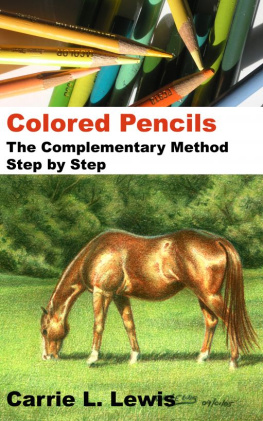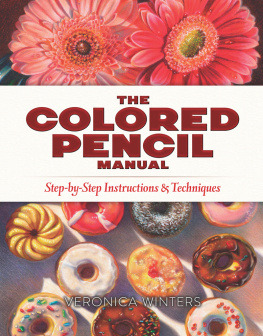Artists Library Series
Colored Pencil Step by Step
with Pat Averill, Sylvester Hickmon, and Debra K. Yaun
Hope Is Yours for the Seeking by Pat Averill
2003, 2011 Walter Foster Publishing, Inc.
Artwork on 2003 Pat Averill.
Artwork on front cover and 2003 Sylvester Hickmon.
Artwork on back cover and 2003 Debra Kauffman Yaun. All rights reserved.
Digital edition: 978-1-61059-841-5
Softcover edition: 978-1-5601-0719-4
This book has been reproduced to aid the aspiring artist. Reproduction of the work for study or finished art is permissible. Any art produced or photomechanically reproduced from this publication for commercial purposes is forbidden without written consent from the publisher, Walter Foster Publishing, Inc.
Contents
Introduction
Colored pencil is a simple, versatile mediumit can be used to replicate the look of oils, watercolor, acrylic, and more. Although it has been used as a fine art medium for less than a century, its popularity has grown significantly over the last few decades. Its easy to understand why more and more artists are attracted to colored pencilsthey are fairly inexpensive and convenient to transport. They are also nontoxic, easy to find in art and craft stores, and combine well with other media. Whether you choose to use colored pencils for sketches or to create fully rendered drawings, you will find that they are brightly hued and precise tools that are a joy to work with.
There are many different approaches and techniques to discover in colored pencil artfrom layering and hatching to burnishing and blending. As you explore this art form, youll discover many methods and materials that will help you realize the seemingly endless creative possibilities working with colored pencil offers. The important thing is to have fun while you develop your own artistic styleand enjoy creating your own works of art in colored pencil!
Little Red Rivals by Sylvester Hickmon
Tools and Materials
You dont need many supplies to get started in colored pencil, so you wont need to invest a lot of money. All you need in the beginning are a few basic colors, an eraser, a sharpener, and some paper. (For the projects in this book, refer to for the colors the artists use in their lessons). Just remember to buy the best supplies you can afford; with better-quality supplies, your artwork will stay as vibrant and colorful over time as it did when you first created it. Then, after youve become more familiar with the variety of effects you can create, you may want to purchase a few more specialized tools. As colored pencil is becoming a more popular medium, many new products are being developed to aid the colored pencil artist.
Pencils
As with all art supplies, the price of a pencil indicates its quality; better pencils have truer color. Many brands offer sets of pencils that provide a basic array of colors. Some art stores also sell colored pencils individuallythis way you can pick and choose which hues you like best among several different brands. Once youve chosen your palette, make sure to store your pencils upright or safely in a containerand try not to drop them. The lead in a colored pencil is very brittle, and its likely to break in the shaft if the pencil is dropped. This may not be immediately apparent, but will eventually render the pencil useless.
Choosing Pencils There are many types of colored pencils availableharder, thinner leads are ideal for rendering fine lines and detail, while softer, thicker leads are great for filling in large areas. Some manufacturers make both hard, thin lead and soft, thick lead versions of the same colors. Experiment to find which types you prefer.
Erasers
Colored pencil artists cant use ordinary erasers to correct their work; the friction between a rubber or vinyl eraser and the paper will actually melt the wax pigment and flatten the tooth (or grain) of the paper. Instead many artists use a small battery-powered eraser to remove the pigment without crushing the paper underneath. A kneaded eraser is also useful for removing small amounts of color; twist or pinch it into any shape you like and then press it lightly on the page to pick up the pigment. When it gets dirty and is not as effective, you can knead it (like dough) thoroughly to reveal a clean surface.
Papers
Textured papers are best for colored pencil work because the rough grain catches the color so it accepts more pigment than a smooth paper would. Art and craft stores carry a variety of textured watercolor papers and illustration boards that offer a good tooth for colored pencil art; look for a paper with a medium grain to start. For practice or for doing quick studies on site, youll want to have a sketch pad or sketchbook. You might also want to consider experimenting with different colored papers and specialty papers; these surfaces can help you achieve some interesting effects. (See for more information on special papers.)
Colored papers
Textured papers
Sharpeners
You can achieve various effects depending on how sharp or dull your pencil is, but generally youll want to make sure your pencils are sharpened at all times; a sharp point will ultimately provide a smoother layer of color. Although a small hand-held sharpener will do, an electric or battery-operated sharpener is better suited for fine art purposes. You can also use a sandpaper pad to refine a pencil point.
Extras
Youll need a dust brush to gently remove the pencil residue from your paper, a spray-on fixative to preserve your finished drawing, and a paper blending stump to create soft blends. A pencil extender is handy when the pencil gets too short to hold onto comfortably, and you may want a triangle for making straight lines and some artists tape for masking. Its also nice to have white gouache and a small brush on hand for adding tiny opaque highlights.
Sandpaper pad
Hand-held sharpener
Blending stump
Kneaded eraser
Next page











